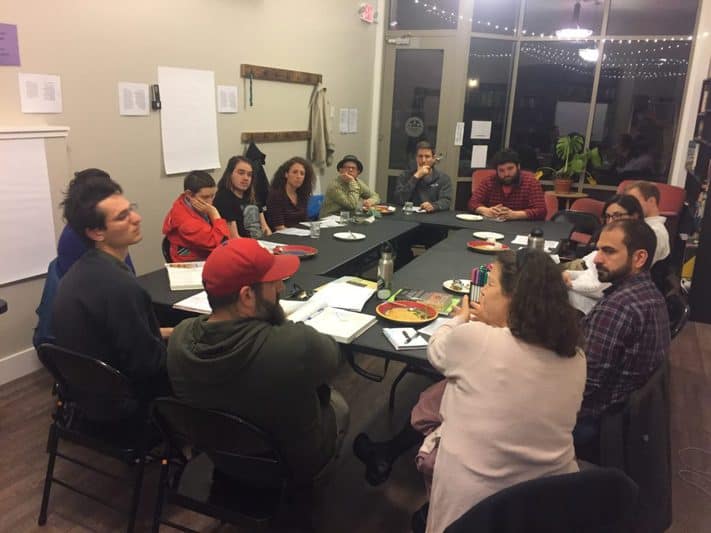by Alex Voynow, Jewish Farm School
Parshat Chukat
In Chukat, our mother dies.
“Miriam died there [at Kadesh] and was buried there. The people were without water and they joined against Moses and Aaron.” ~Numbers 20.1-2
Miriam’s death gets one line, and then the narrative is quickly redirected back to the patriarchs. I was amazed at the amount of lines the Torah takes in Chukat to explicate the condemnation of Moses, the laws or ritual purification, and the military proceedings of the Israelites, while one verse is all we hear about the death of Miriam the Prophetess.
Miriam provided the water. And just as in the central focus of the movement at Standing Rock, “Water is Life.” Mayim chayim.
If you say mayim repeatedly, you also begin to say ima — mother. In the Torah, we lost our mother Miriam, our life source. She is barely mentioned again.
So, the central question for me and for us that comes up is: whose story is this? Who wrote this book? There is an obvious reality that women were centrally important to the life and culture of the Israelites, yet they are seldom mentioned, celebrated, or mourned. I see this as the Torah’s infidelity to the truth; it makes me suspicious of the motives of those men who wrote it, and it makes me sad. It also makes me wonder what was happening in all those deep gaps, and how can imagining into them help us remember, and how can it help my and our Judaism?

Miriam the prophetess leading praise by the seashore; facing her miraculous well as the sages pictured it. At left is Serah, daughter of Asher (Gen. 46:17; Num. 26:46), another scriptural woman who sustained the Jewish people throughout the generations, according to legend. Detail of a painting by Riky Rothenberg. Courtesy of Riki Rothenberg.
At the Jewish Farm School, our philosophy and practice is rooted in the ancestral agricultural teachings in the Torah. With all the Torah’s gaps, we’ve begun to ask: what are we, as an organization, missing? We want to maintain a firm ground in our ancestral texts, and also be in conversation with their patriarchy and violence, with the ways they don’t serve our contemporary community. How can our relationship to the Torah’s stories be made more whole?
Our way into this inquiry was to initiate a study group, open to the community, diving into the historical relationship between Jews and land. We’ve been seeing what it feels like to try to weave together competing and coexisting stories and histories of our people.
We were aiming to feel into the past and fill the gaps that we’re left with, to see if we can inherit a sense of wholeness. What’s been happening is an invigorating rocking between mind-blowing disorientation and clarity, where we’re finding that “who we are” and “who were we” are not distinct questions, that history can never be a singular noun, and that the past is not in the past. We’re learning to remember with a grounding in our own feelings, and into the land itself and all that springs from it–human, spirit, and their confluence. This is our process of flowing from being people of the book, back to being people of the earth.
A central lesson from Chukat, for me, was about mourning. When we live into our histories in this way, we begin to process, and to mourn. Mourning, in a way, is to see myself in a relationship to the past and to the present, not just in a relationship to a processional march towards the future, towards a destiny. It’s about marking and honoring time, and honoring the space that my body and soul are asking for. It’s something that I haven’t learned how to do well, because my society and my tradition hasn’t really taught me, even though Jewish tradition is rich in mourning practices.
What happened to the Israelites when they didn’t mourn the death of Miriam?
Or did they mourn her, but we’re simply not told the story? We know they mourned for Aaron — who died soon after — for 30 days instead of the usual seven.
I wonder how it really went down, but the story in this Torah portion seems to go: she dies, Moses strikes the stone, the leaders are condemned. They hasten the end of their wandering, they seek to enter land, the people of those lands don’t want them there, they take up arms, almighty god-as-weapon allows them to displace people and take their land.
And that’s the story we have now.

Visual representation of moses striking the rock/the stiff wave of patriarchy | photo: JWitness Forum
Visual representation of moses striking the rock/the stiff wave of patriarchy
What did the Israelites need in that moment? Miriam, Aaron, and, finally, Moses were the last ones to remember Egypt, and the generation at Kadesh is the first to live in the tension between inherited destiny and inherited trauma. In that tension, the Israelites had a choice: what modality of leadership do we as a people follow?
As we ourselves feel back into history, we perhaps feel the stiff wave of the masculine sweep over the people as they leave behind Miriam’s body. Decisions were made to strike, to invade, to penetrate, to advance, to take.
But other options existed: to gather, to feel, to listen, to heal.
We have the same choices now. We can choose the parts of ancestral spirits and story into whose memory we want to live.
Here is guidance, medicine, and a spell offered to us by Alicia Ostriker in part of her poem The Songs of Miriam:
What did I have but a voice, to announce liberty
No magic tricks, no miracles, no history
No stick
Or stone of law. You who believe that God
Speaks only through Moses, bury me in the desert
I curse you with drought
I curse you with spiritual dryness
But you who remember my music
You will feel me under your footsoles
Like cool ground water under porous stones
Follow me, follow my drum
Follow my drum, follow my drum
Follow me, follow my drum
Follow my drum
Moses, it is said, dictated the Torah. I don’t take that as fact, but I do take it as truth.
His sister died on the same day he was condemned; can we blame him for the selfishness of his memory?
I believe this story can be liberated from the shortcomings of our forefathers. We can breathe our fears and desires and our grief and our question into the spaces they left for us, and step back and feel that, finally, it is memory whole and true. Then, we can sit there for a while, and process, and mourn, and gather, and heal, and look at each other in the eyes, as a people.
And then, if we’re ready, we can move forward towards our collective destiny.
Alex Voynow is the JOFEE Fellow at Jewish Farm School and grew up in the Pine Barrens, 45 minutes east of Philly, where his growing wonder of trees and forest soil mingled with a discomfort and distrust of mainstream suburban lifestyle. He combines his love and understanding of food and agroecology with a commitment to social and ecological justice and community organizing. Read his full bio here.
—
Editor’s Note: Welcome to D’varim HaMakom: The JOFEE Fellows Blog! Most weeks throughout the year, you’ll be hearing from the JOFEE Fellows: reflections on their experiences, successful programs they’ve planned and implemented, gleanings from the field, and connections to the weekly Torah portion and what they’ve learned from their experiences with place in their host communities for the year. Views expressed are the author’s and do not necessarily represent Hazon. Be sure to check back weekly!





Comments are closed.